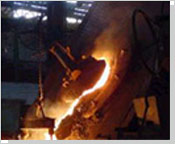 The metal pattern is first heated at a temperature of 200ºC / 392ºF. Then covered with a mixture of sand and thermoset plastic. It forms a skin of sand / plastic mixture of about 3.5 mm (0.125 inch) which adheres to the pattern. The shell mold is formed after the skin gets removed from the pattern. The two halves of the shell mold are secured together and the metal is poured in the shell to form the part. Once the metal solidifies, the shell is broken.
The metal pattern is first heated at a temperature of 200ºC / 392ºF. Then covered with a mixture of sand and thermoset plastic. It forms a skin of sand / plastic mixture of about 3.5 mm (0.125 inch) which adheres to the pattern. The shell mold is formed after the skin gets removed from the pattern. The two halves of the shell mold are secured together and the metal is poured in the shell to form the part. Once the metal solidifies, the shell is broken.
- Good Surface Finish: 1.25µm to 3.75µm (50µin to 150µin) rms Dimensional tolerance of 0.5%
- Size Limits: 30g to 12kg (1 oz to 25 lb)
- Minimum Thicknesses: As low as 1.5 mm (0.062 in) to 6.25 mm (0.25 in), depending on the material Superior Machining Qualities: As it has soft skins and hard or dense interiors.
- Draft Allowance: Typically 1°C
Application of Shell Mold Casting:
The materials that can be used with this process are aluminum, cast irons, and copper alloys. Parts made can be connecting rods, gear housings, lever arms etc.
